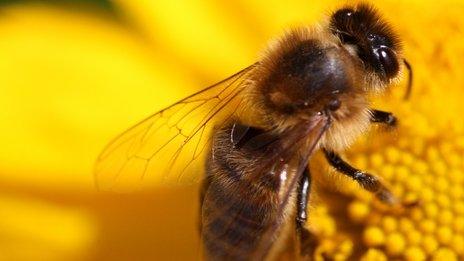Search for Welsh honey with antibiotic elements launched
- Published

Scientists hope to create a special honey by leading bees to plants with strong antibacterial elements
Scientists looking for a new antibiotic are hoping Welsh beekeepers will be able to provide a solution.
Beekeepers are being asked to send in samples of their honey to see if it contains antibiotic elements.
If any is found, DNA techniques will then be used to determine which flower is responsible.
The search will be led by one of the science and technology exhibitions at this year's National Eisteddfod in Llanelli.
Dr Arwyn Jones of the Cardiff School of Pharmacy and Pharmaceutical Sciences said: "It's an extremely exciting process and it would be wonderful to find antibiotic elements in honey on the eisteddfod maes.
"If we do manage to find something, it's possible we can create a special honey by leading the bees to plants with strong antibacterial elements."
New drugs
The eisteddfod exhibition looks at the role of the Barcode Wales in the fight against infection.
The Welsh Bar Code has been developed with several Welsh universities, the National Botanic Garden of Wales and International Bee Research Association and has created DNA bar codes for 1,143 indigenous flowering plants and conifers in Wales.
Barcodes are short DNA sequences and plants can be identified from pollen grains, seed pieces, or roots and wood.
Scientists are testing the ingredients in honey against infections like Clostridium difficile
It is hoped this will help conservation and develop new drugs.
Eisteddfod science officer Dr Robyn Wheldon-Williams said: "The antibiotic elements of honey have been recognised for many years, and honey was used in wound dressings as long ago as the Middle Ages.
"The elements of the New Zealand honey, Manuka, have long been established and is known as 'liquid gold'.
Welsh beekeepers can either take their 200g honey sample to the eisteddfod maes when the festival comes to Llanelli, from 1 to 9 August or send it beforehand.
Samples can be posted to: Dr Arwyn Jones, Cardiff School of Pharmacy and Pharmaceutical Sciences, Redwood Building, Edward VII Avenue, Cardiff, CF10 3NB.
- Published26 June 2012

- Published9 April 2013

- Published13 April 2011